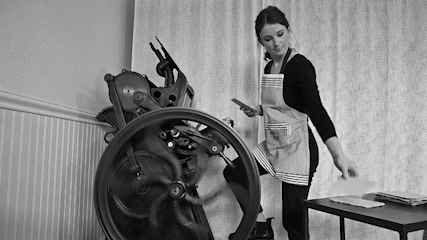Birdsong Bespoke exclusively creates letterpress wedding invitations. But what exactly are they? How are they made? And why are they more expensive? Let me explain.

What is Letterpress Wedding Stationery?
Letterpress printing is an ancient art form. The first known mechanical printing press was invented in the 14th century by Johannes Gutenberg with tiny little wood blocks formed into letters. He would decide what he wanted to print, arrange all the letters, “lock them up”, add ink, and then print! Block type was used before this manually dating as far back as 175 AD in China. A tactile printing technique, letterpress printing creates a deep, three-dimensional impression (debossing) on thick cotton papers and cardstocks. As a wedding stationer and letterpress printer, I design and print letterpress wedding invitations, save-the-dates, and day-of paper goods and signage for my clients’ weddings.
Letterpress Machinery

Letterpress stationery is often just called “letterpress” after the name of the machine that creates it. My letterpress machine, Birdie, is from the early 1900s. She is a platen press, which brings two surfaces — the base for the design plates, and the platen for the paper — together with immense force, like a clamshell, to produce the print. The machinery is analog, meaning it’s powered by me as the letterpress operator using a foot treadle (or pedal) and a fly wheel.
I purchased Birdie from the Printing Museum in Houston, Texas, after a long search for the perfect machine. She’s a bonafide antique and 800 lbs of solid cast iron, which is super fragile, so I hired a specialty moving company to transport her from Houston to my wedding invitation studio in Boulder, Colorado.
The Letterpress Printing Process
Unlike digital printing techniques, letterpress printing involves a multi-step process spanning design, make ready, and printing.
Letterpress Design
Designing for letterpress is a process in and of itself: the design starts as a sketch, which gets turned into a vector (a computer file), and then created into three-dimensional letterpress plates. To design for letterpress is an exercise in equal parts beauty, science, technique, and ingenuity. I have to be able to “see” the end product as I first put pencil to paper, as each design requires specific attention to line widths, layers, overlapping elements, and color.
Make Ready
The letterpress machine requires an extensive process to make it ready for printing. It begins with oiling the machine through her 24 oil ports; Birdie runs the risk of fracturing or shearing off if she isn’t well-oiled.
Once oiled, I prepare the base so I can adhere the polymer design plates to it. The plate has to be aligned precisely to make sure the design will print correctly on paper. Then I prepare the platen for the paper, carefully adjusting the scraps of paper and chipboard underneath the paper to make sure I achieve the right impression depth.
Next, I mix the ink colors by hand using a color formula guide, and ink up the press. The ink is put on an ink disc and the machine is run for several minutes to get it evenly distributed on the rollers. Birdie can only print one color at a time, which is why designs with multiple colors are more expensive; I have to clean and re-ink the press for each color I want to print.
Lastly, I run test prints to perfect the alignment of the design on the paper, the printing depth in the paper, and the ink color. It can take two to 10 prints to get these just right. I use special rulers and alignment guides to make sure the design is perfectly centered, straight, and that the impression is even.
Letterpress Printing
Once the press is ready for printing, I can finally print your gorgeous letterpress wedding invitations, which are hand-fed through the machine one at a time. The printing and make ready process is the same whether I’m printing 10 or 300 prints, which is why smaller print quantities have a much higher “per unit” cost, and why letterpress isn’t typically priced per unit or per card.
Are Letterpress Wedding Invitations Worth the Investment?
It’s no secret that letterpress wedding invitations cost more than digital printing, but as I hope the explanation of the printing process made clear, that’s because each one is its own work of art. Unlike with digital prints that are created by an electronic machine at the touch of a button, my letterpress wedding invitations are individually crafted with care and heart by a true artisan. Your wedding guests can literally feel the love imprinted into the double-thick cotton paper as they hold your wedding invitation. In my opinion, that makes bespoke letterpress wedding stationery well worth the investment. If you agree, I’d love to work together to make paper magic for your wedding!